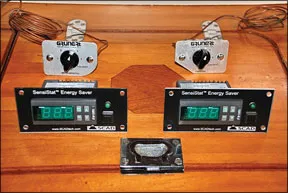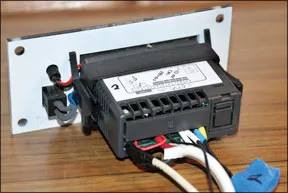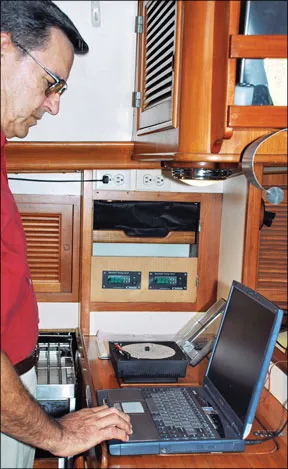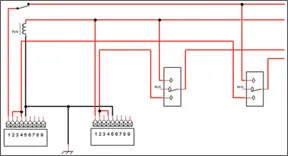Modern galley refrigeration moved far beyond simple holding-plate refrigeration systems, and now competes with the more easily installed evaporative refrigeration systems. One key to efficiency in any refrigeration system is an accurate thermostat. Practical Sailor compares a more expensive digital thermostat to a traditional, less expensive mechanical capillary thermostat. Refrigerator and freezer tests pitted the Grunert Marine Air Systems mechanical capillary refrigeration thermostats against the Scad Technologies SensiStat digital thermostat. Mechanical thermostats are valued for their simplicity and reliability, but a digital thermostat may outperform mechanical thermostats when it comes to maximizing marine refrigeration performance.
****

In the dark ages of marine refrigeration-about 30 or 40 years ago-a timer or simple switch was used to activate the electric clutch of an engine-driven automotive air-conditioning compressor until a holding plate in the refrigerator box was completely frozen. When the holding plate had thawed to the point where it could no longer keep the compartment cool, the cycle began again. With some experimenting, a cruising sailor could learn to operate this type of system fairly efficiently.
Modern marine refrigeration installations have moved far beyond this simple, but still viable approach. Holding-plate systems now compete in a market where less expensive and more easily installed evaporative systems have become commonplace. (An upcoming article in Practical Sailor will compare the latest 12-volt evaporative systems.)
In either system the thermostat can hold the key to efficiency, although how it functions in each is quite different. In an evaporative system, a refrigerant is circulated through the insulated box, removing heat with each circuit. To maintain the proper temperature, the cooling cycle is repeated at fairly frequent intervals. The thermostat in the evaporative system is tasked with monitoring the box temperature, starting the system at a preset level, and stopping it when the compartment is cooled sufficiently.
In a holding-plate arrangement, the tubing of an evaporative system is replaced by a grid of refrigerant tubing immersed in a eutectic solution. To cool the box, the system compressor must be run until the holding plate is completely frozen. Then, over a period of several hours, the holding plate absorbs heat from the compartment until it thaws, and the compressor must be re-started to repeat the cycle. Compared to evaporative systems, the holding plate behaves more like an ice block, capable of maintaining a cool box for longer periods when power is unavailable.
In the holding-plate system, the thermostat cannot directly control the compartments temperature. Instead, it plays a two-part role in determining holding plate efficiency. First, it must decide when the eutectic solution is frozen. Then, at the opposite end of the sequence, the thermostat must determine when the holding plate has thawed to a point at which it can no longer adequately absorb heat.
At either point of the cycle, if the thermostat waits too long to start or stop the compressor, the compressor runs more often than is needed, reducing efficiency.
For many years, refrigeration thermostats have consisted of a metal capillary tube (usually copper) connected to a diaphragm in the thermostat housing. When the sensor or bulb at the end of the capillary tube is placed on the holding plates surface, a change in temperature leads to a change in pressure that moves the diaphragm. The diaphragm movement activates a switch, which, in turn, starts and stops the refrigeration compressor. Often referred to as mechanical thermostats, they don’t require electrical power to function and the reference temperature or “setpoint” is adjustable. Some delay or hysteresis is incorporated into the switch design to prevent rapid cycling of the switch near the setpoint. Typically, this differential temperature range is about 10 degrees. but some mechanical thermostats can be adjusted to alter the range.

In more recent times, digital technology has migrated to thermostats. Not only do these devices bring the convenience of a digital display, but they feature an almost infinite adjustment of the setpoint and the differential temperature. Like its mechanical counterpart, the digital thermostat controls the operation of the refrigeration system components with a built-in switch but it also requires electrical power to operate. These devices often use a thermistor (a device whose resistance varies with temperature) or thermocouple (a device that generates current proportional to the heat it is exposed to) to translate temperature changes into electrical current that controls the thermostat. The mechanical thermostats are touted for their reliability, low cost, and ability to function without electrical power. Advocates of digital thermostats claim better accuracy, versatility, and efficiency.
After many years of experience with Grunert mechanical thermostats that are fairly representative of the traditional mechanical thermostat, we decided to put them up against the SensiStat, a modern digital thermostat offered by Scad Technologies. Although a digital thermostat offers some benefits for evaporative system, the most significant efficiency gains would be expected with holding plate systems.
The Scad retails for more than three times the Grunert, so there were many questions that needed to be addressed. Would a digital thermostat improve efficiency enough to produce a noticeable savings in energy? Did the claims for greater convenience and versatility really justify the added expense? What about the installation itself?
What We Tested
Since the test included both fridge and freezer comparisons, we used two Grunert mechanical capillary refrigeration thermostats, one for the fridge (#A30-544/72, $70) and one for the freezer (#A30-2290-00, $67). The 72-inch capillary tubes on each of these units is long enough to allow remote mounting. The controls include an off position and an uncalibrated range of settings indicated by the numbers 1 through 6. The thermostats cannot be used interchangeably to control a freezer or a refrigerator system, but they don’t require electrical power to function.
Our digital sensor and display was the new SensiStat developed by Scad ($300). The device requires 12- or 24-volt power supply and automatically determines the supply voltage. An automatic compressor protection creates a minimum delay of 5 minutes between compressor runs. Thirty seconds after battery charging is detected, the unit enters a “Free Power” mode that changes the pre-programmed differential temperature to 1 degree. This starts the refrigeration system to take advantage of the extra power available from the alternator. A user-activated manual override mode changes the pre-programmed differential temperature to 1 degree for 60 minutes for extra freezing time, if needed.
The manual override mode can be canceled, and “Free Power” mode can be disabled, if desired. Either the compartment or the plate temperature can be displayed continuously. The other can be momentarily displayed when desired. Supply voltage is monitored, and an over-voltage condition will prevent the refrigeration system from running until it is corrected.

An LED indicates when the SensiStat is requesting the refrigeration system to run while another LED indicates the current mode and provides feedback when programming some parameters.
Various parameters can be adjusted to allow the SensiStat to be used with either a freezer or refrigerator. The following parameters can be programmed by the user:
- Setpoint temperature.
- Differential temperature range.
- Differential temperature range used by “Free Power” and override modes.
- Displayed temperature in Fahrenheit or Celsius.
- Voltage level used to detect engine alternator output.
How We Tested
The test system consisted of a separate freezer and refrigerator, each regulated by separate thermostats that control a common system compressor but separate solenoids valves. The valves only allowed refrigerant to enter the holding plates of the compartment that each thermostat was controlling. System parameters were monitored with a Dickson Temperature Chart recorder with the probe mounted on the holding plate in the compartment being monitored. Voltage, amp/hrs. and time were monitored with data recorded once per second by computer.
The evaluation was conducted by first recording the performance of both the freezer and refrigerator for several days with the Grunert mechanical thermostats installed. Data was recorded at several different thermostat settings, and then the procedure was repeated with the SensiStat digital thermostats installed. Care was taken to place the probes or sensors for both types of thermostats at the same location on the plates as recommended by the holding plate manufacturer. Both the refrigerator and freezer compartments were filled to 75 percent of capacity with typical food items and sealed. The temperature was allowed to stabilize before data recording began. The average air temperature outside the compartments was 86 degrees.
What We Found
The “Free Power” mode did a nice job of detecting engine operation when the alternator began to charge. Cruisers have been doing this manually for years, but the SensiStat wont forget to reset the system after the anchor is down.
There may be some unexpected consequences of this feature. Solar panel or wind charger output may trigger this mode if the batteries are fully charged, or it may be activated by a momentary interruption in shore power, if this causes the charger to leave the float mode. You can program the voltages for activating and terminating the “Free Power” mode and can also set the differential temperature referenced while in this mode. It is possible to disable the “Free Power” mode when shore power is connected for extended periods, which would be a good idea. Some of the instructions for making these settings could be better.
It would also be better if the SensiStat included a connection for a high temperature alarm, a welcome addition to any installation.
Digital monitoring of the refrigerator or freezer compartment temperature is a nice feature and a good tool for making adjustments, but a significant amount of temperature stratification may exist, especially in the freezer. Locating this sensor near the compartment center vertically is probably the best choice, but the coldest area will still be at the bottom of the compartment.

The manual override mode works as advertised and did a good job of shortening the amount of time it took to freeze new items in the freezer. Unless you cancel the mode, it will hold the cold plate within 1 degree of the setpoint for 60 minutes.
Conclusions
Directions for installing the SensiStat sensors and display are well documented and easy to follow. The display is designed to be panel-mounted externally where it can be easily monitored. Sensor wires (unlike capillary tubes) can be extended as needed. Retrofitting is also straightforward, though you might have to add a ground wire at the thermostat location.
Mechanical thermostats are valued for their simplicity and reliability, but a digital thermostat may often outperform it when it comes to maximizing system performance. The accuracy and repeatability of temperature measurements (within .10 of a degree for the SensiStat) delivered by a digital thermostat certainly contributes to efficiency, but its biggest asset may be its ease of use and versatility. The SensiStat was notably better than the mechanical thermostat when it came to getting the most out of the system, but the setpoint and differential temperatures should be mapped to the characteristics of your holding plates. The default settings may not be the best option.
From a performance standpoint, the digital thermostat would seem to be the clear winner here. Reliability remains to be seen, but readers have reported good customer support from Scad for its other products. Based on the SensiStats performance during testing, it would be a good choice when considering a digital thermostat.
Compared to a mechanical thermostat, the SensiStat is not cheap, but we expect the prices for digital sensors to come down as the technology takes hold.





































